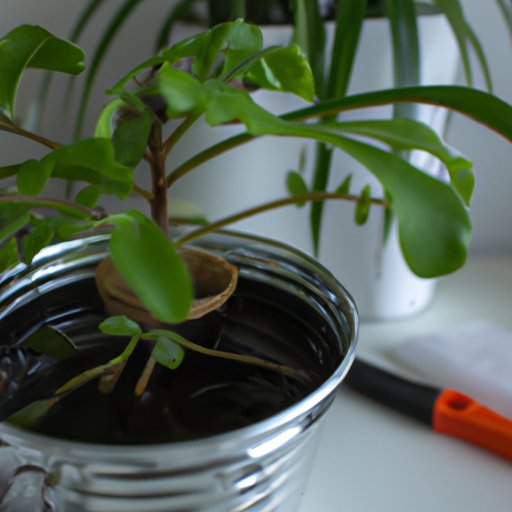Introduction
Gnats are small, annoying flying insects that can be found in many different environments, including indoors. They are attracted to moist soil and organic matter, which makes them common pests of indoor plants. Not only do they feed on the plants, but they can also cause damage to the foliage and roots of the plants, leading to stunted growth and poor health. In this article, we will explore how to get rid of gnats in indoor plants.
Use a Soap and Water Solution to Spray the Plants
One way to get rid of gnats in indoor plants is to spray them with a soap and water solution. To make this solution, mix one teaspoon of dish soap with one quart of warm water. The soap helps to break down the waxy outer layer of the gnats, which results in dehydration and death. When spraying the plants, be sure to cover the entire plant, including the undersides of the leaves, to ensure that all of the gnats are killed. This method is safe for both people and plants, and it is effective at controlling light infestations of gnats.
Place Yellow Sticky Traps Near the Plants
Another way to get rid of gnats in indoor plants is to place yellow sticky traps near the plants. These traps are made from a special adhesive material that attracts gnats and other small flying insects. To make the traps, cut pieces of yellow construction paper or cardstock into small squares, then coat the squares with a thin layer of petroleum jelly. Place the traps near the plants, and the gnats will be attracted to the yellow color and stick to the traps. This method is relatively inexpensive and easy to do, and it can help to control heavy infestations of gnats.

Bring in Beneficial Insects Such as Ladybugs or Praying Mantis
Introducing beneficial insects into your home is another way to get rid of gnats in indoor plants. Ladybugs and praying mantis are two of the most common beneficial insects, and they both feed on gnats and other small insects. To introduce these insects, simply purchase them from a garden center or online retailer and release them near the plants. Be sure to provide them with food and water, and they will help to keep the gnats under control.

Prune Away Any Dead or Dying Foliage
Dead or dying foliage can attract gnats, so it is important to prune it away to reduce the number of gnats in your home. Pruning away dead or dying foliage helps to create an environment that is less conducive to gnat activity, and it also helps to improve the overall health of the plants. To prune away dead or dying foliage, use a pair of sharp scissors or pruners and carefully remove any affected leaves or stems. Be sure to dispose of the clippings in a sealed container to prevent them from attracting more gnats.
Remove Excess Moisture From Soil by Allowing it to Dry Out Between Waterings
Excess moisture in the soil can attract gnats, so it is important to allow the soil to dry out between waterings. To do this, wait until the top few inches of soil has dried out before watering the plants. If the soil is too wet, consider adding a layer of mulch or gravel to help absorb the extra moisture. This will help to keep the soil dry and reduce the number of gnats in your home.

Introduce Predatory Nematodes into the Soil
Predatory nematodes are tiny worm-like creatures that feed on gnats and other small insects. To introduce them into the soil, purchase them from a garden center or online retailer and mix them into the soil around the plants. Be sure to follow the instructions on the package for best results, and keep in mind that they need to be kept at a certain temperature and humidity level in order to be effective. This method is relatively inexpensive and easy to do, and it can help to control heavy infestations of gnats.
Conclusion
Getting rid of gnats in indoor plants can be tricky, but it is possible with the right methods. Spraying the plants with a soap and water solution, placing yellow sticky traps near the plants, introducing beneficial insects, pruning away any dead or dying foliage, removing excess moisture from soil by allowing it to dry out between waterings, and introducing predatory nematodes into the soil are all effective ways to get rid of gnats in indoor plants. For more information on how to get rid of gnats in indoor plants, consult a local gardening expert or search online for additional resources.


